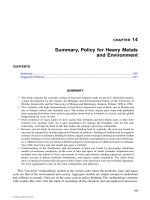Chapter 14 pot
Bạn đang xem bản rút gọn của tài liệu. Xem và tải ngay bản đầy đủ của tài liệu tại đây (259.3 KB, 45 trang )
© 2008 Pearson Prentice Hall, Electronic Commerce 2008, Efraim Turban, et al.
Chapter 14
E-Commerce Strategy
and Global EC
14-2
Learning Objectives
1. Describe the strategic planning
process.
2. Describe the purpose and content of a
business plan.
3. Understand how e-commerce impacts
the strategic planning process.
4. Understand how to formulate, justify,
and prioritize EC applications.
14-3
Learning Objectives
5. Describe strategy implementation and
assessment, including the use of
metrics.
6. Evaluate the issues involved in global
EC.
7. Analyze the impact of EC on small and
medium-sized businesses.
14-4
Organizational Strategy:
Concepts and Overview
strategy
A broad-based formula for how a
business is going to accomplish its
mission, what its goals should be, and
what plans and policies will be needed to
carry out those goals
14-5
Organizational Strategy:
Concepts and Overview
Strategy and the Web Environment
e-commerce strategy (e-strategy)
The formulation and execution of a vision of
how a new or existing company intends to
do business electronically
14-6
Organizational Strategy:
Concepts and Overview
Strategy and the Web Environment
strategic information systems planning
(SISP)
A process for developing a strategy and
plans for aligning information systems
(including e-commerce applications) with
the business strategies of an organization
14-7
Organizational Strategy:
Concepts and Overview
The Strategic Planning Process
Strategy initiation
Strategy formulation
Strategy implementation
Strategy assessment
14-8
Organizational Strategy:
Concepts and Overview
14-9
Organizational Strategy:
Concepts and Overview
strategy initiation
The initial phase of strategic planning in
which the organization examines itself
and its environment
14-10
Organizational Strategy:
Concepts and Overview
Specific outcomes initiation phase
include:
Company analysis and value proposition
value proposition
The benefit that a company’s products or
services provide to a company and its customers
Core competencies
Forecasts
Competitor (industry) analysis
14-11
Organizational Strategy:
Concepts and Overview
strategy formulation
The development of strategies to exploit
opportunities and manage threats in the
business environment in light of
corporate strengths and weaknesses
14-12
Organizational Strategy:
Concepts and Overview
Specific activities and outcomes from the
formulation phase include:
Business opportunities
Cost-benefit analysis
Risk analysis, assessment, and
management
Business plan
14-13
Organizational Strategy:
Concepts and Overview
strategy implementation
The development of detailed, short-term
plans for carrying out the projects agreed
on in strategy formulation
14-14
Organizational Strategy:
Concepts and Overview
Specific activities and outcomes from the
strategy implementation phase include:
Project planning
Resource allocation
Project management
14-15
Organizational Strategy:
Concepts and Overview
strategy assessment
The continuous evaluation of progress
toward the organization’s strategic goals,
resulting in corrective action and, if
necessary, strategy reformulation
14-16
Organizational Strategy:
Concepts and Overview
Strategic Planning Tools
SWOT analysis
A methodology that surveys external
opportunities and threats and relates them
to internal strengths and weaknesses
competitor analysis grid
A strategic planning tool that highlights
points of differentiation between competitors
and the target firm
14-17
Organizational Strategy:
Concepts and Overview
scenario planning
A strategic planning methodology that generates
plausible alternative futures to help decision
makers identify actions that can be taken today to
ensure success in the future
balanced scorecard
A management tool that assesses organizational
progress toward strategic goals by measuring
performance in a number of different areas
14-18
Business Planning in E-Commerce
business plan
A written document that identifies the
company’s goals and outlines how the
company intends to achieve those goals
14-19
Business Planning in E-Commerce
Outline of a business plan
Executive Summary
Business Description
Operations Plan
Financial Plan
Marketing Plan
Competitor Analysis
14-20
Business Planning in E-Commerce
Business Plan Fundamentals
Purposes for business plan
To acquire funding
To acquire nonfinancial resources
To obtain a realistic approach to the business
business case
A business plan for a new initiative or
large, new project inside an existing
organization
14-21
E-Business Strategy:
Concepts and Overview
14-22
E-Strategy Initiation
Issues in E-Strategy Initiation
Be a First Mover or a Follower?
Born-on-the-Net or Move-to-the-Net?
Determining Scope
Have a Separate Online Company?
Have a Separate Online Brand?
14-23
E-Strategy Formulation
Selecting EC Opportunities
Incorrect approaches to EC strategy selection:
1. Indiscriminately funding many projects and hoping for a
few winners
2. Betting it all in a single, high-stakes initiative
3. “Trend-surfing”
Productive approaches to EC strategy selection
1. Problem-driven strategy
2. Technology-driven strategy
3. Market-driven strategy
4. E-business maturity model
14-24
E-Strategy Formulation
Determining an Appropriate EC
Application Portfolio Mix
The BCG model
An Internet portfolio map for selecting
applications
14-25
E-Strategy Formulation









